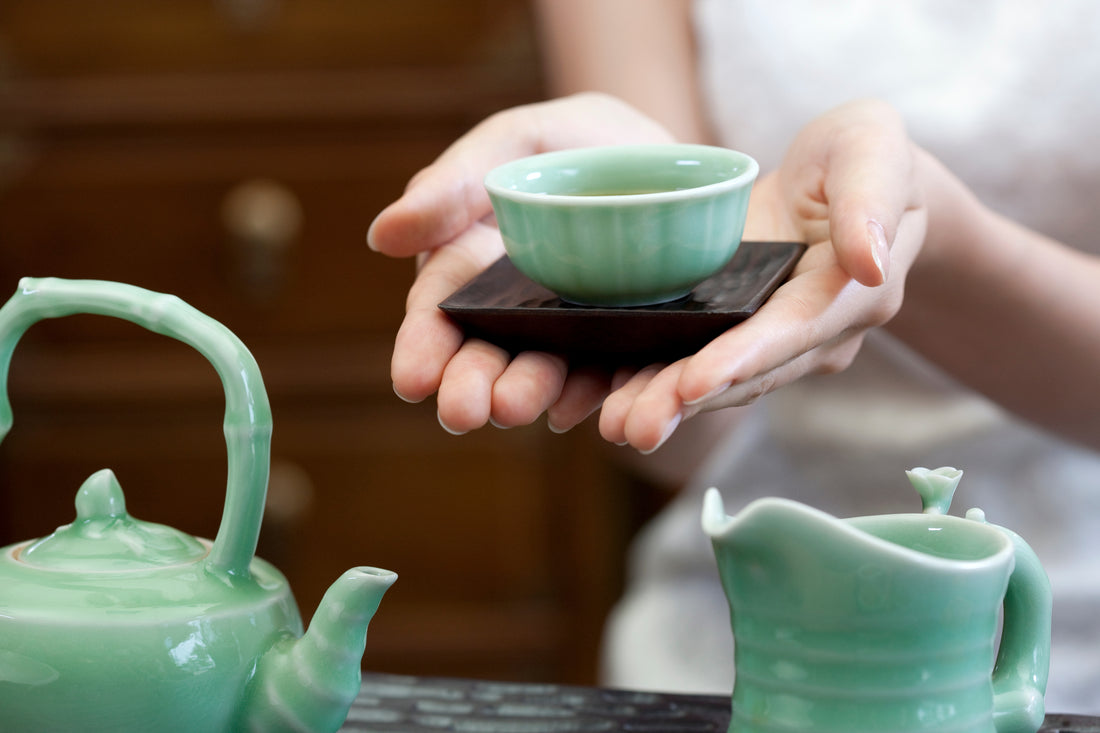When you think of China's magnificent ceramic history, celadon wares, with their lustrous glazes ranging from muted greens to azure blues, undoubtedly come to mind. The term "celadon," a Western appellation, merely scratches the surface of the depth and breadth of these Chinese ceramics. This article uncovers the enchanting world of Chinese celadon wares, exploring ten prominent types that span various dynasties and regions.
1. Siqianyao Kiln: A tale from the Eastern Han dynasty (25-220 AD) speaks of the birth of the Siqianyao kiln. Its legacy laid the foundation for many of the celadon traditions that were to follow.
2. Yue Yao (越窑, Yue ware): Tracing its roots back to the Six Dynasties period (220-589 AD) in northeastern Zhejiang, Yue Yao stands as one of the pioneering celadon traditions in China. Renowned for its signature grey-green hue, Yue ware encapsulates the essence of early Chinese ceramic artistry. The development of its distinct color, often reminiscent of jade, not only set a standard for beauty and refinement in pottery but also laid the foundation for subsequent celadon wares. Crafted with meticulous attention to detail, the kilns producing Yue ware were highly revered, with some pieces even finding their way into imperial collections.
3. Yaozhou Yao (耀州窑, Yaozhou ware): Steeped in the rich legacy of the Five Dynasties period (907-960), Yaozhou Yao emerged as a prominent celadon style that drew inspiration from the revered Yue ware. Originating from the kilns of northern China, particularly in modern-day Shaanxi, this ware is celebrated for its intricate symmetrical patterns and innovative carving techniques. Over time, the craftsmen of Yaozhou evolved their own distinctive style, masterfully layering textures and patterns that gave depth and character to each piece. The glaze, often a rich green, beautifully complemented the carved designs, resulting in pieces that were both visually captivating and tactilely delightful.

A very rare carved Yaozhou Petal-Rim. Northern Song Dynasty, XI century. Christie's
4. Longquan Celadon (龙泉青瓷): From the verdant heartlands of Zhejiang province during the Northern Song dynasty (960-1127), the splendor of Longquan Celadon came to life. As a distinguished successor of Yue ware, Longquan celadon bore its own mark of excellence with distinctive glazes that transitioned from subtle yellow-green hues in its early days to mesmerizing blue-green shades by the Southern Song dynasty (1127-1279). The harmonious blend of color and the often thick, lustrous glaze made Longquan celadon a beacon of ceramic achievement. With elegant shapes and a sometimes translucent quality, these wares garnered immense appreciation, finding homes in imperial courts and overseas through ancient trade routes.
5. Ge Yao (哥窑, Ge ware): Branching out from the Longquan family is Ge ware. Crafted by the older Zhang sibling, Zhang Shengyi, Ge ware became an emblem of refined taste and artistic innovation during the Song dynasty. Its defining feature is the distinctive "crackled" glaze, characterized by a spiderweb of lines often accentuated with dark ash.
6. Di Yao (弟窑, Di ware): Crafted with gentle hands and a discerning eye, Di Yao, also known as Di ware, is a unique chapter in the legacy of Longquan celadon. Born from the creative vision of the younger Zhang sibling, Zhang Shenger, Di ware carries its own distinctive charm. Unlike its counterparts with resonant, metallic timbres, Di Yao surprises with a muted sound, thanks to its slightly porous nature. This porousness, combined with a lighter weight and unique soft-textured feel, makes Di Yao particularly endearing. It's crafted in such a manner that even when filled with piping hot tea, the exterior remains comfortably warm, not scalding. Marrying functionality with an elegant aesthetic, Di Yao stands as a testament to the Zhang family's ingenuity and the enduring versatility of Chinese celadon.
7. Ru Yao (汝窑, Ru ware): The legend of Ru ware, one of the "Five Great Kilns," began 800 years ago in the Song dynasty. Despite its fleeting existence of only ~40 years, many celadons thereafter sought inspiration or even replication from the standards set by Ru ware. Modern ceramists, particularly from Jingdezhen, recognizing the value of this lost art, have embarked on reviving the Ru tradition, crafting contemporary pieces with the same finesse and allure. With its subtle crackles, which mature beautifully when exposed to darker teas, Ru ware continues to enchant, symbolizing a blend of imperial luxury and masterful craftsmanship.


8. Jun Yao (鈞窯, Jun ware): Sharing its birthplace with Ru ware in Henan, Jun ware developed arguably the most unique celadon glaze. Its glaze, thick and lustrous, dances with hues ranging from a soft azure to deep purples. This captivating color play, especially the purple splashes, owes its magic to the deft addition of copper during the glazing process. Jun ware's opalescent appearance, enriched by countless tiny bubbles formed by addition of lye during firing, makes each piece a universe unto itself. These pieces are so tiny, they often remain invisible to the naked eye. However, they scatter light in a manner that predominantly allows blue light to pass through, imparting a distinctive hue. This is the same phenomenon responsible for the blue color of our skies, known as Rayleigh scattering.

Bulb Bowl (Shuixian Pan). China, Henan Province, Linru County, late Jin dynasty or early Yuan dynasty, about 1200-1300
Furnishings; Serviceware
Jun ware, molded stoneware with blue glaze and purple splashes
The Ernest Larsen Blanck Memorial Fund (60.27.3). Chinese Art.

Jun Bracket-Lobed Narcissus Bowl. Yuan-Ming Dynasty, XIV-XV century. Christie's
9. Guan Yao (官窯, Guan ware): As the Southern Song dynasty set its roots following the fall of its northern counterpart in 1127, the world of Chinese ceramics welcomed the illustrious Guan ware. This "official" celadon, as the name suggests, was a noble attempt to emulate the revered Ru ware from the past, but with the inherent uniqueness of its own. Crafted from different kilns and materials, Guan ware unfurled with a spectrum of glazes, ranging from muted ivory to deep browns and greys. A distinct feature that set it apart was the deliberate emphasis on its crackled glaze, creating a myriad of patterns across the ware.
10. Ding Yao (定瓷, Ding ware): A paragon of grace and innovation, Ding ware shines in the annals of Chinese ceramic history. Characterized by its pristine white color, Ding Yao embraced the advent of coal firing, elevating its firing temperature beyond what wood kilns could achieve. Although the formulation for this white glaze was conceptualized during the Tang Dynasty, its true brilliance emerged in coal-fired kilns where the absence of excess oxygen resulted in its trademark pure white hue. What further distinguishes Ding ware is its subtle decorative flair, often expressed through moldings or delicate engravings.

A rare and finely carved Ding 'Lotus' dish. Northern Song Dynasty. XI-XII century.
The dish has angled sides rising from a broad base supported on a short foot to a flaring rim which is bound with a copper band. The interior is skilfully carved and combed to depict a single lotus sprig, adorned with sketchily carved leaves. It is covered in a pale ivory glaze pooling in areas to the base, part of which is unglazed and has been fired to a slightly warmer tone.
Christie's
In Conclusion: Chinese celadon wares are not just products of clay and fire but are interwoven tales of innovation, legacy, and craftsmanship. Each type, from the Siqianyao kiln's inception to the intricate designs of Ding ware, captures an epoch of ceramic artistry. At TeaJewel, we cherish these legacies and invite you to dive deeper, exploring both the rich history and modern renditions of these Chinese treasures.
Resources:
Christie's Collecting guide: Chinese celadon ware ceramics
The Earliest Chinese Proto-Porcelain Excavated from Kiln Sites: An Elemental Analysis
China Daily: A heritage to hold dear
Research on the kiln site protection and utilization of early Yue in
Zhejiang based on protection first

